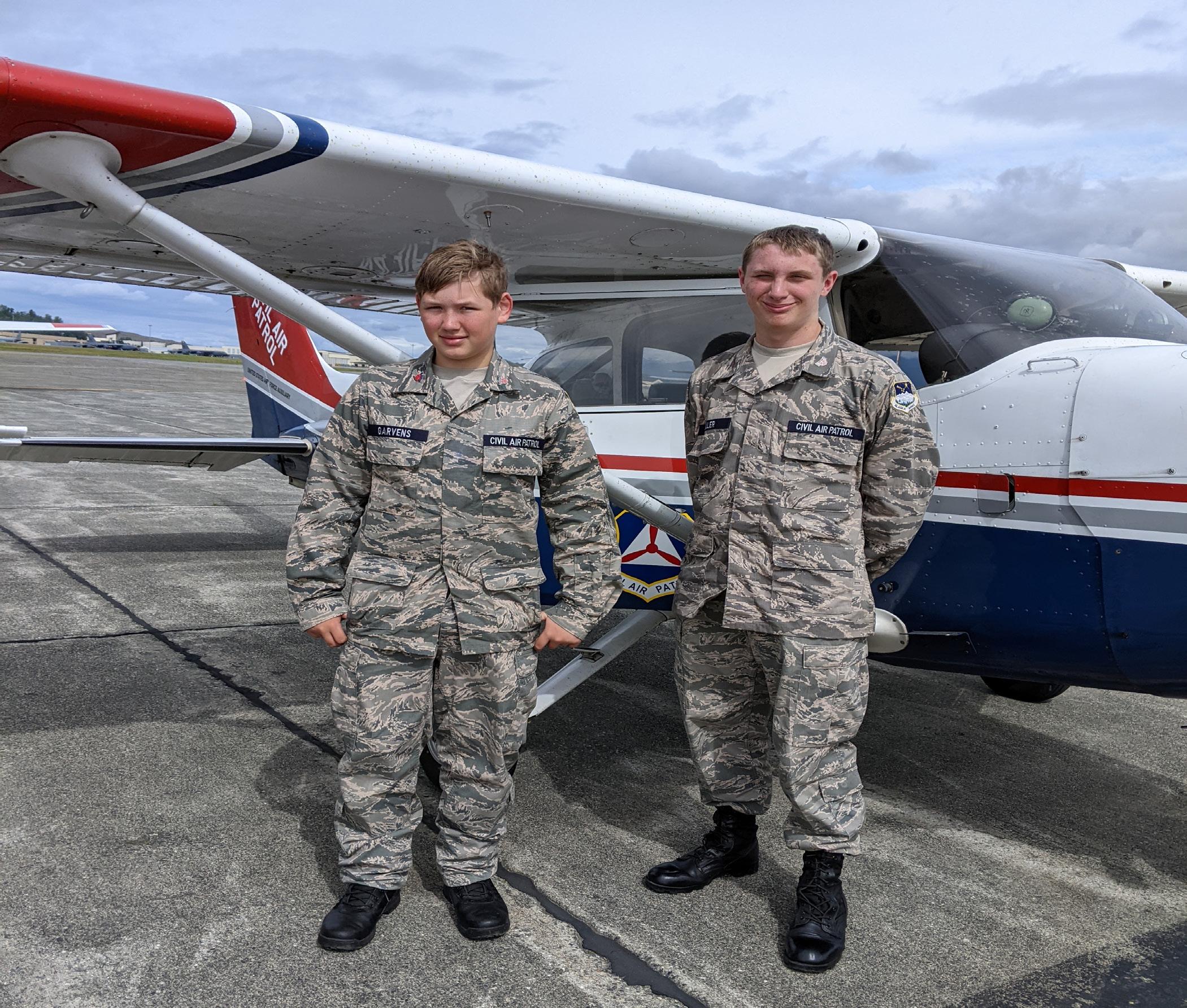
13 minute read
Arcturus Squadron
C/Amn Keegan Garvens and C/ SSgt Thomas Buller, from Arcturus Squadron, flew their first powered orientation flight on July 12. They located the F101 Voodoo wreck near the Big Susitna River, swapped seats at Wasilla Airport, and then flew to the Goose Creek cabin (aka the
"Dr Zeuss" multi-story cabin). Upon return to Elmendorf AFB, they also had the opportunity to see how the Becker DF system worked to locate an actual emergency beacon that was still active at Big Lake Airport.
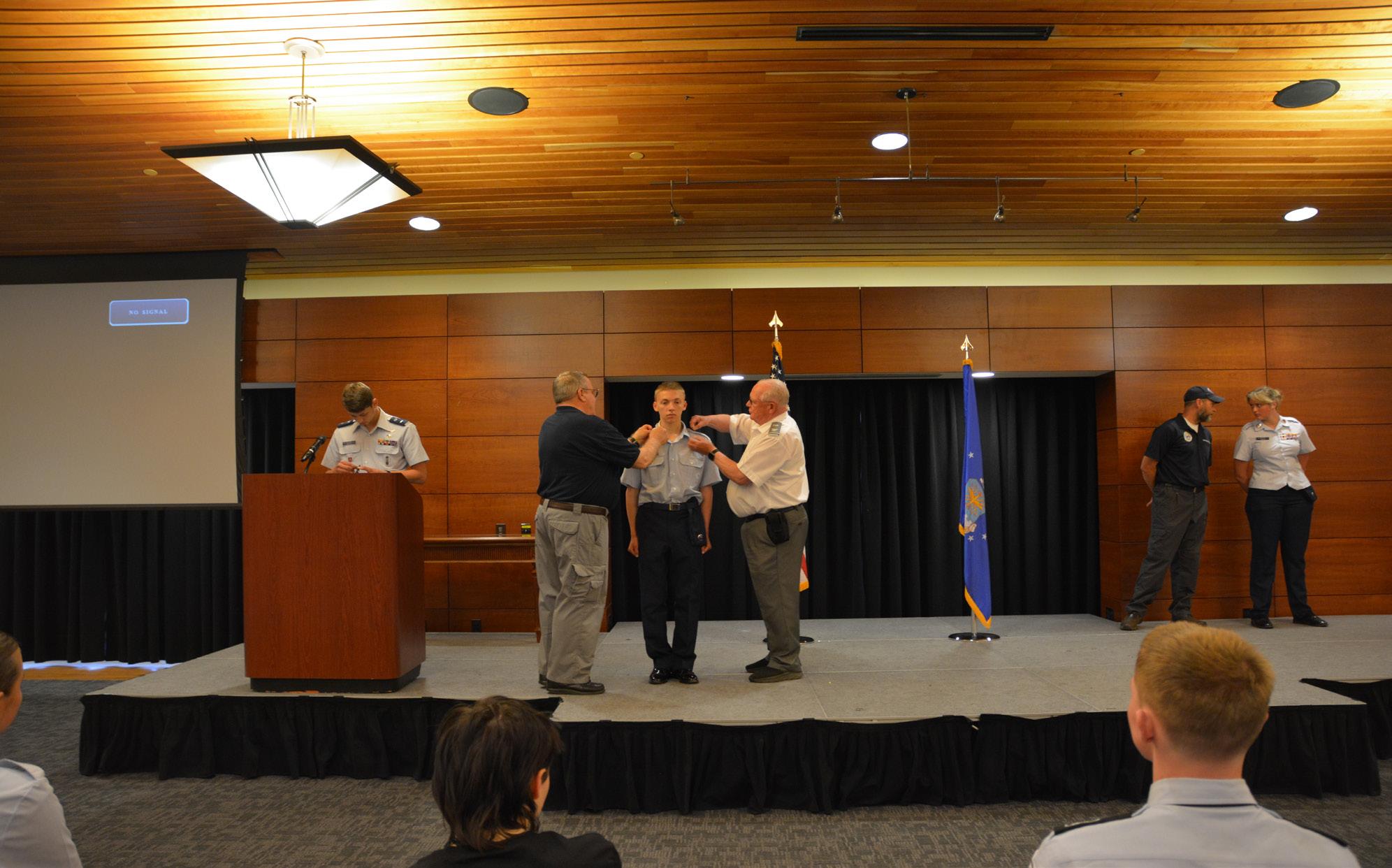
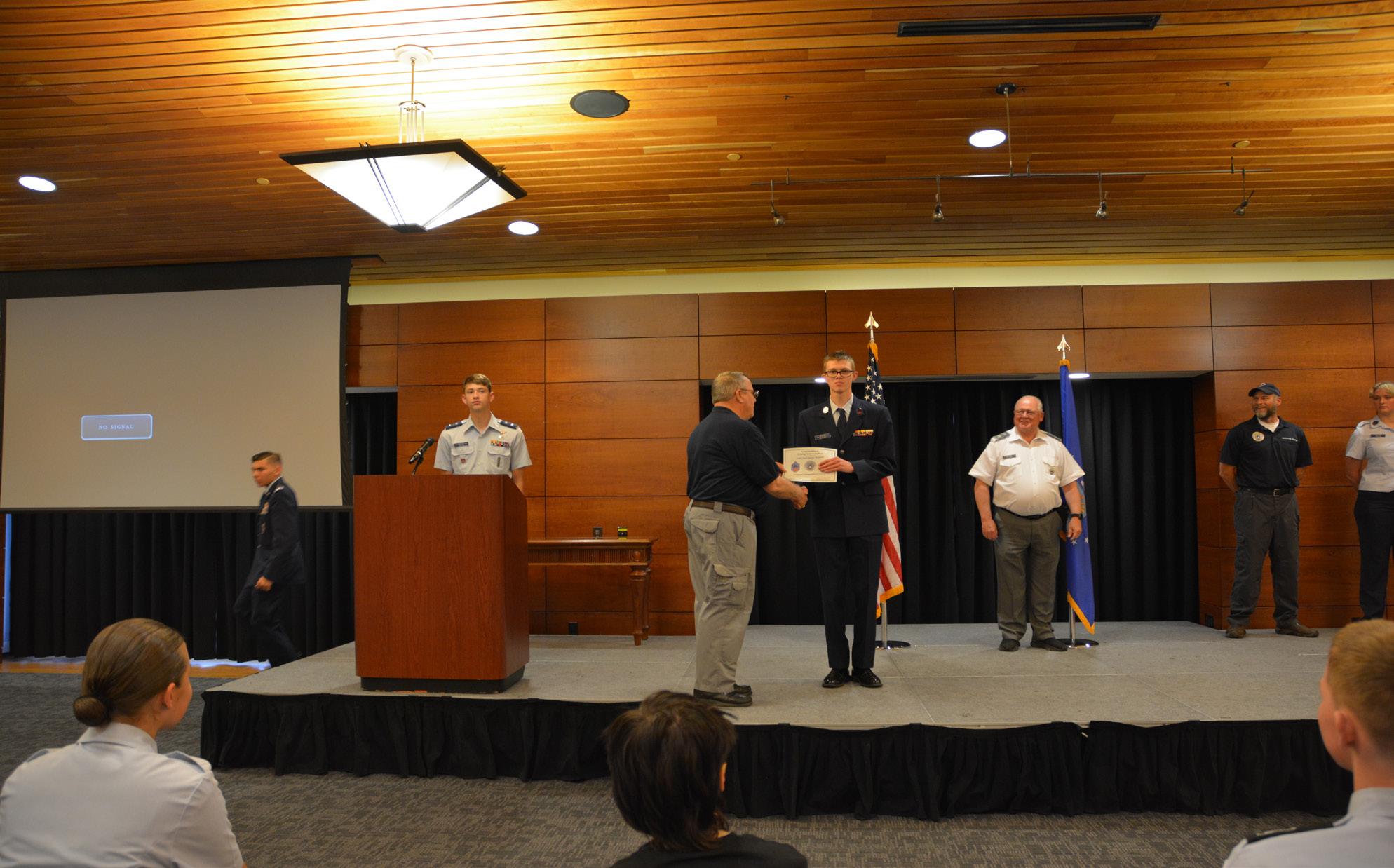
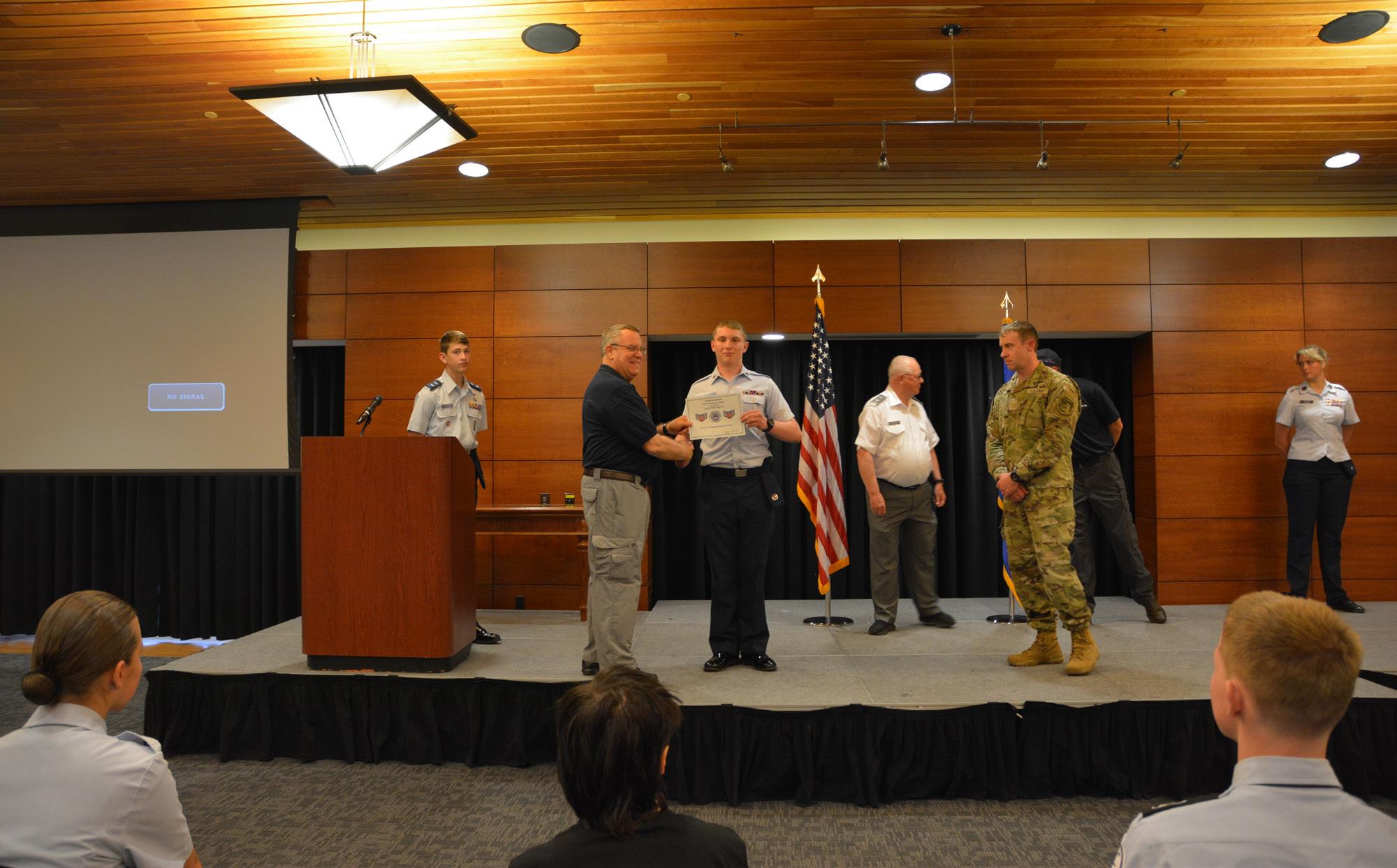

Some of Senior Members and Cadets celebrating their

Promotions with the presence of the wing commander.

Delta Force
The squadron welcomes the unit’s newest cadet, Wesley Marshall. Marshall has experience in JROTC and will be an asset to the squadron. The unit currently also has 3 guest students attending and considering joining CAP. Three new senior members have joined the squadron in the last few weeks.
WELCOME to senior members
Lt Col Robert Cargel (Fort Greely Garrison Chaplain)
David Adams (Engineer and Pilot)
Capt Benjamin Russell (AKNG HHB
Commander Missile Defense, Pilot, CFII)
Cong Tulations
are due to the promotions
C/Amn B Cargel
C/Amn C Cargel
C/SrA Ashley Gaston
C/SrA Alexandra Gaston
C/A1C Alexis Harwood
C/MSgt C Schmidt.
The Wingman Course was held for 3 new cadets and potential cadets. C/MSgt C Schmidt assisted in teaching the course.
The unit’s August Character Development lesson of the topic of Humility had a great level of involvement amongst the cadets. At times it was reminiscent of college-level philosophy 101! Squadron Deputy Commander Maj Jorge Lorenzana assumed Fort Greely 49th Missile Defense Battalion Command and was promoted to Lt Col in July. CONG TULATIONS
Lt Col Robert Cargel spoke to the squadron in July regarding Airborne Operations, its history, Airborne School, and his more than 200 jumps. It was a fascinating and very inspiring presentation.
Capt Baugh led the squadron in a productive meeting of learning ES skills this month. Several cadets received powered orientation flights in July, thanks to the support of the Tok squadron and pilot Capt White. Cadet Marshall and C/Ashley Gaston happily took their first o-flights. 4 cadets accompanied Capt Baugh and Capt Schmidt to the Eielson Air Show to support the CAP booth and displayed aircraft.
The squadron is growing and it’s encouraging to see the work cadets are doing for promotions. The unit is currently meeting at Fort Greely on Tuesday nights.


Delta Force Cadet Completes Medical Orientation Training School NCSA
In July, CAP C/MSgt Caitlynn Schmidt attended the 10-day MOTS National Cadet Special Activity, class 2308, located at the TXWG HQ in Nacogdoches, TX.
C/MSgt Schmidt explained, “Attending MOTS was a great experience. It was the most exhausting and fun experience I’ve ever had. Everyone worked as a team.

The instructors were very helpful. I learned about triage, bag mask rescue breathing, clearing secretions by suctioning, giving oxygen; how to splint, immobilize a spine, place someone on a backboard, take vital signs, joint immobilization, how to take a medical assessment and a trauma assessment, stop bleeding, and treat poisoning patients. They had many scenarios that we randomly would get called to and treat patient(s). We learned how to build a system with ropes for rescue, if needed, requiring learning many knots. We did patient extraction and low-angle rope rescue training.”
“Each cadet was able to go up in a bucket truck, which was amazing. We had guest speakers every day. We were able to see a Houston County Air Rescue helicopter land and transport a patient. One night we were awakened by dispatch tones and rushed to a mass casualty scenario of 11 patients and spent 2 hours triaging, treating and transporting, including rope rescue.”
“Before the NCSA, there was quite a bit of class work to complete, as well as Basic Life Support Provider certification. During the NCSA, there were 4 online tests, 12 hands-on practical tests, and a final exam. I’ll be able to take the National Registry

of Emergency Medical Responders
Exam for certification.” “I made some new friends, and everyone became kind of like family. The food was great, with lots of snacks. The weather was extremely hot and humid.”
“I’d recommend it to anyone who’s up to the mental and physical challenges of MOTS,” finished Schmidt.
Cadets also learned how to treat a K9 dog named and had a patient canine named Blitzkriegon which to practice. They learned how to make Swiss Seat harnesses for the rope rescue. They were timed on their skills and had to keep working better and faster as the activity continued. Students learned about the roles and responsibilities of various healthcare providers and were able to interact with them and be briefed on the education and skills required for those careers. They met 2 of the Air Force Critical Care Air Transport Team members.

They learned about “hauling,” which assisted them on the Tower.
Schmidt begins a 2-year part-time college EMT program for high school juniors and seniors in August with Arkansas Tech University. Some of the training at MOTS was EMT-level, so she has a great beginning.
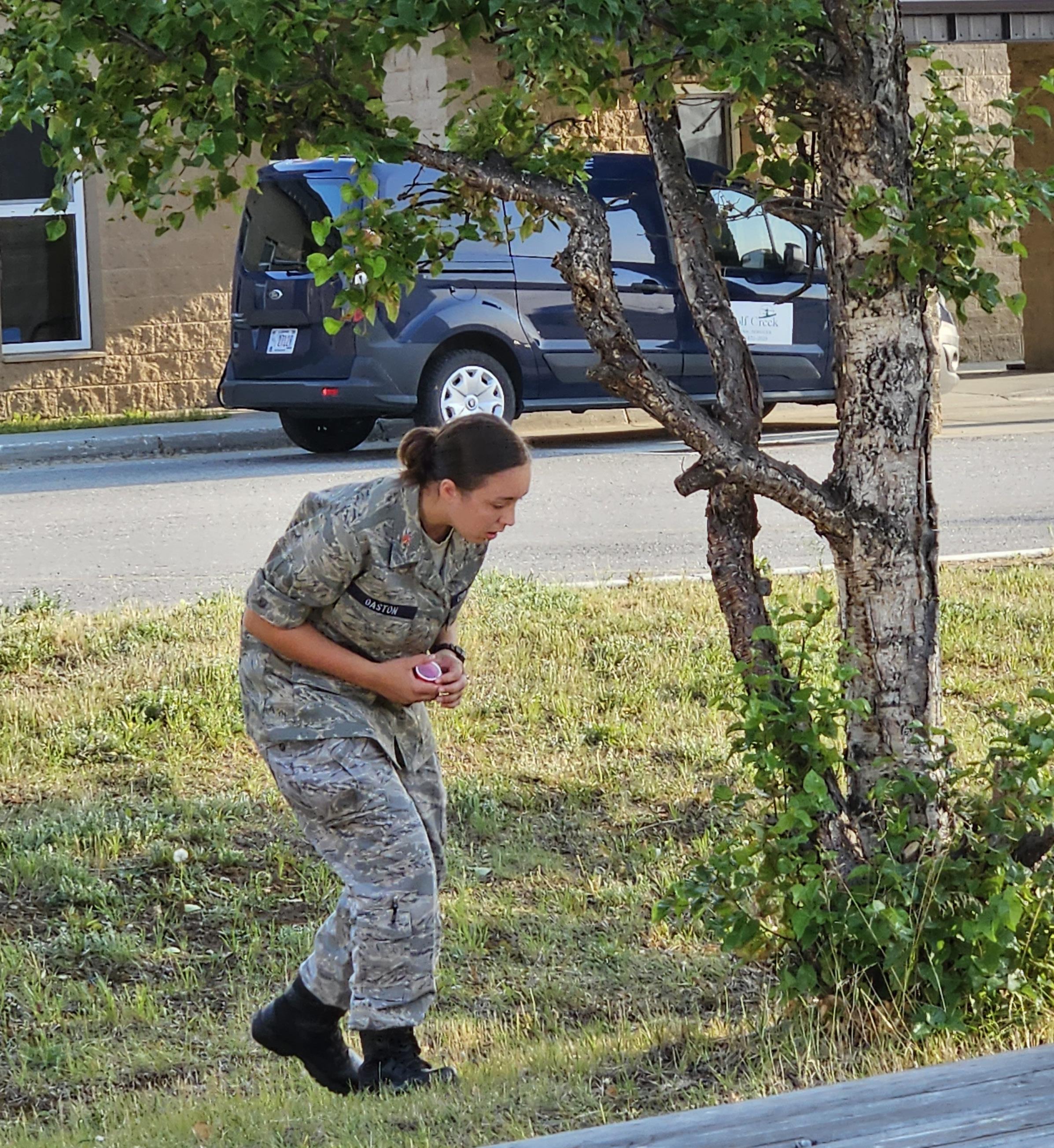
AK Wing assists U.S. Coast Guard with air transportation in rural Alaska during mission ‘Arctic Shield’

From July 25 through August 1, 2023, three CAP AK Wing members and pilots, Maj. Ben Padgett, TFO Ryan Padgett (both Lake Hood Cadet Squadron) and Maj. Martin Krebs (Polaris Squadron), assisted the U.S. Coast Guard with air transportation to communities around Nome, Alaska. The mission was coordinated by LtCol Sammons, AK Wing Director of Emergency Services.
Two GA8 aircraft were flown from Anchorage to Nome for the mission. At the Nome airport, the Army National Guard Facility Commander, Captain Schuler, invited CAP to tie down the planes on the Guard Ramp and use the National Guard facilities. This was very helpful as it provided a common meeting point for all crews to stage in the morning and come together in the evening to plan and brief the next day. The AK Army Guard was also assisting the Coast Guard on this mission with flights on its Blackhawk helicopter based in Nome/Bethel.
Including the relocation flights, CAP flew 25 sorties for this Nome mission. Passengers on the flights were Marine Science Technicians of the USCG, stationed in Anchorage, who were accompanied by inspectors from the EPA’s Anchorage office on some flights. Their task was to inspect fuel tanks which get filled by boat in all of the communities in the area, which included both a physical inspection of the tanks and fuel lines and headers, as well as a check of the record keeping, personnel training and emergency planning of the operator.
Although initially assumed to be a VFR transportation mission, continuously poor flying weather dictated the flights to be conducted under IFR. To reduce the operational risk inherent in singlepilot IFR flying to mostly unfamiliar airstrips, the crews decided to operate all IFR flights with a two-pilot crew. The forecasted and reported weather often required the release to be done by a Senior Flight Release Officer (SFRO). Under CAPR 70-1 a SFRO can release IFR flights if conditions are not worse than 1 mile visibility or a ceiling of 500 ft. One sortie, a return to Nome, showed conditions even lower (but of course above approach minimums) requiring Wing Commander approval of the sortie. Every single leg during the mission, except the relocation flights from and to Anchorage, had to be flown under instrument flight rules due to IFR conditions either at the departure point or the destination or both. Flying IFR, CAP was able to fly on all five consecutive days we were requested to fly (we were not requested on the first and last day of the mission). The Coast Guard was able to inspect all sites it had planned to go to with CAP and even added Deering to our list, since this location did not get inspected earlier in the month out of Kotzebue. Of all locations, only St. Michael was missed.
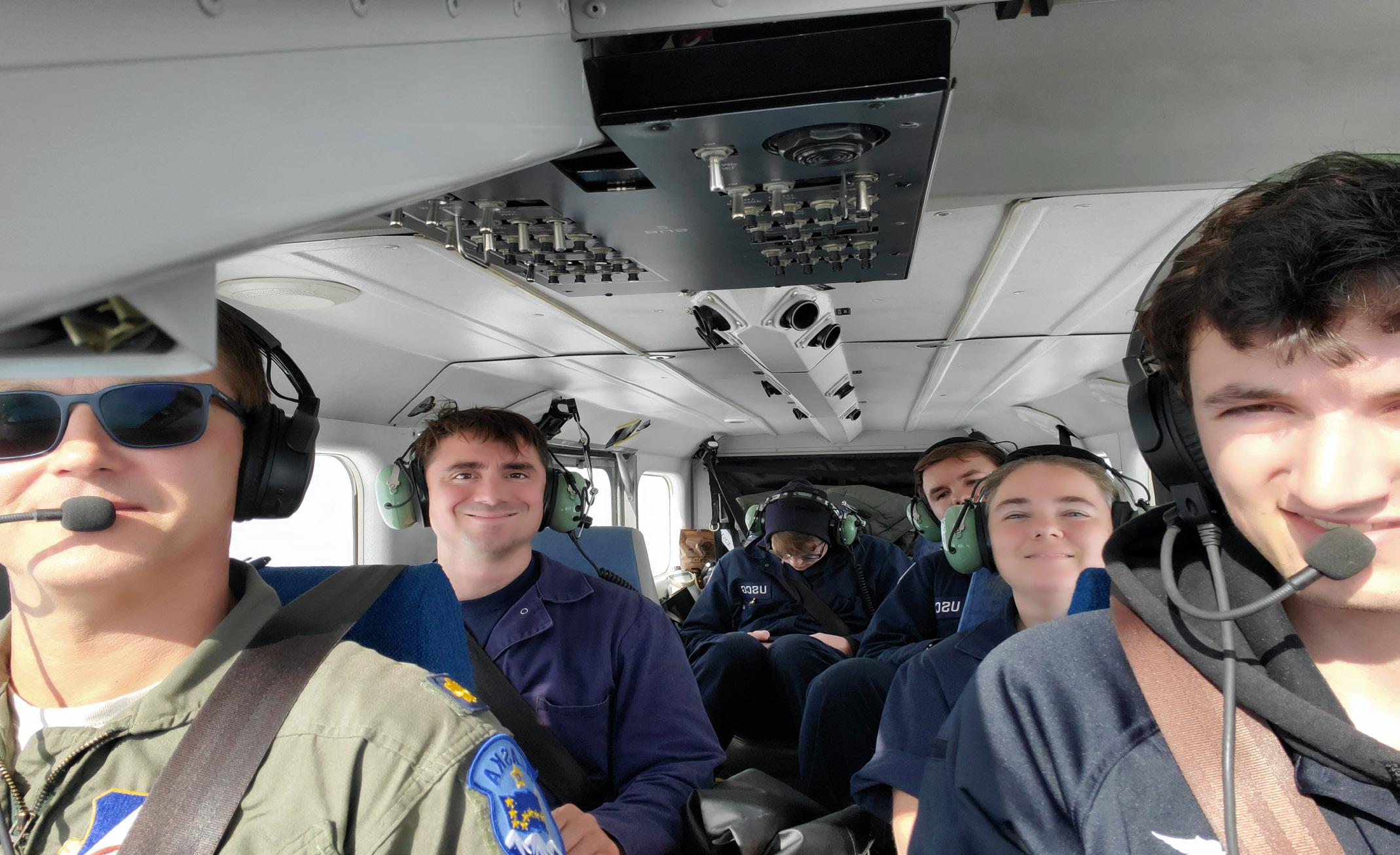
It was to be inspected on the last day by helicopter but weather forced the Blackhawk, which was operating VFR, to return to base. Due to weather and other operational constraints, the Blackhawk was only able to fly on two of the six days of the mission and as mentioned before, had to air return on one of those two days due to weather.
The flying itself was a good refresher on instrument hand-flying skills for the author. Conditions in the clouds were not too challenging though. It was mostly smooth, with usually good visibility below the clouds. Frequently we were able to climb either between layers or on top. Freezing levels were around 10,000 feet but all coastal airways only required between 6,000 to 8,000 feet, so we always had a margin of 2-3 degrees C to the freezing level, which we were monitoring carefully. Needless to say, we never encountered any icing.
Up to four passengers were carried on board of the air van, making fuel planning critical. The air van can hold 88 gallons of fuel, but depending on passengers onboard, full tanks were not always possible.
The FAA has upgraded the IFR system in rural Alaska nicely in recent years. Every village airport has RNAV approaches, usually including at least one LPV approach, and generally one to every runway. Together with the automated weather reporting at those locations and weather cameras in some, IFR flight planning was straightforward. We used Internet where it was available to brief ourselves, but when not had to rely on the good old way of calling Flight Service over the phone for a briefing. When alternate minimums are met, these village airports can even serve as legal alternates. Terminal forecasts only exist for larger locations like Nome, Unalakleet and Kotzebue, so alternate weather determinations have to be based on the current conditions and the area forecast for those smaller strips.

The downside of all this new equipment seems to be that it is putting a strain on the FAA’s upkeep and maintenance resources. Several facilities, including for example the ILS system in Nome, were inoperative, making RNAV approaches there the only viable approach, but with minimums equivalent to the ILS.
The weather was not the only challenge in the field. Apart from the local Alaska Cellphone service, cell phones worked in Nome only. But even there, cellular
Internet was extremely slow, making downloading weather data, filing a flight plan or accessing CAP’s flight management system WMIRS pretty much impossible. Those tasks had to be done on WiFi at the ‘Cottage’, a rental where the CAP crew stayed during their time in Nome. Even when good Wi-Fi existed, the beloved Captcha requirement to get into e-services/WMIRS was severely hindering access. Maj Ben Padgett volunteered to stay behind and took upon the task of communicating with the crew in the field, entering sorties, ORM and all other data into WMIRS, releasing flights and requesting approvals from Wing and the National Operations Center when required. Luckily we had one personal GCI cell phone, so that the crew was able to contact their base from even the smallest village. The onboard Satellite phones on the aircraft were inoperable due to a discontinued service contract. With usually two, sometimes three, locations to inspect during a day, our duty days were long. We had a show time often before 8.00am and usually returned to Nome around 7.00pm. During the inspections we had the choice of staying behind with the aircraft at an isolated village strip or -when enough transportation was available - to accompany the inspectors to the sites or explore the vicinity ourselves. Ground transportation consisted of trucks, including sitting on the bed of the truck in rain, enclosed ATV’s, riding on the back of a four-wheeler or simply walking, when the village was close by. We knew lunch had to be brought along and thus were excited to having fresh-baked pizza during the inspection trip to Unalakleet, the one place with a restaurant, only to find the pizzeria temporarily closed because the owners were on vacation. The inspections lasted between two and six hours per community, depending on the number of facilities there and the preparedness of the operator(s). When staying at or in the aircraft while waiting for the return of the inspectors, the pilots appreciated having a roomier airplane on this mission.
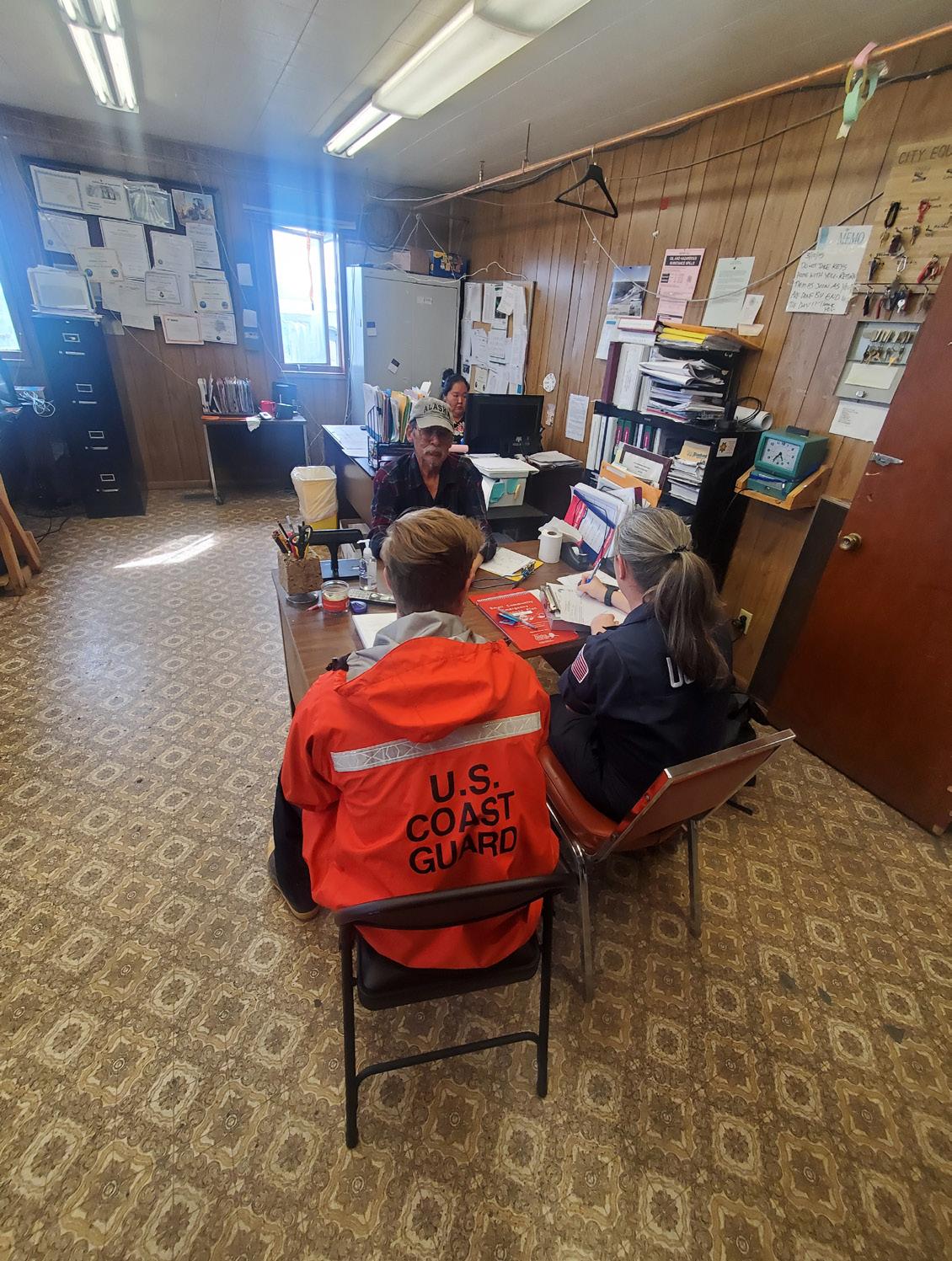


We were glad that Deering was added to the list. Not only was it one of the few places we were able to go to that was ‘clear in a million’, after leaving Nome IFR, providing some nice sunshine during the inspection tour, but it also had a big herd of musk oxen right outside of town which we were able to watch and photograph from the road. Musk Oxen roam the vicinity of Nome, too, but only Maj Padgett got to see them there. They can be dangerous and several people warned us of getting too close to them, citing a recent death of a Trooper in the Nome area who was killed by a musk oxen while defending his dogs. With no flying requested, the last day provided a chance for some sight seeing in Nome and the author had the opportunity to visit the Nome Museum. It is in an all-new building a little outside of town, but turned out great. Most exhibits are interactive, provide a wealth of information both about the earliest settlements in the Nome area by native tribes as well as the explosion of the town during the gold rush and the subsequent decades. The entrance is free and should be on your list if you come to Nome. All in all, we had a great experience and
Everyone involved on their side was appreciative and pleasant to work with. I am sure you can be find us on a future mission.

Good news, let's WELCOME our newest member to the Public Affair team.
2nd Lt Mercy Freeman joins the Alaska Wing as Asst. Public Affairs Officer (PAO), reporting to Lt Col Bryan Emerson. Known by her friends as “Capt. Crunch” for her number crunching skills, Lt Freeman will focus her attention on analyzing data related to member retention (Retention reports to PAO). She may participate in Communications, too, since she is an amateur radio operator.

She was raised in Vermont, where she was homeschooled before college, and then moved to Colorado, where she took nursing courses. For a number of years, she worked as a correctional peace officer in a medium security prison for men in Idaho.
Welcome, Lt. Freeman.
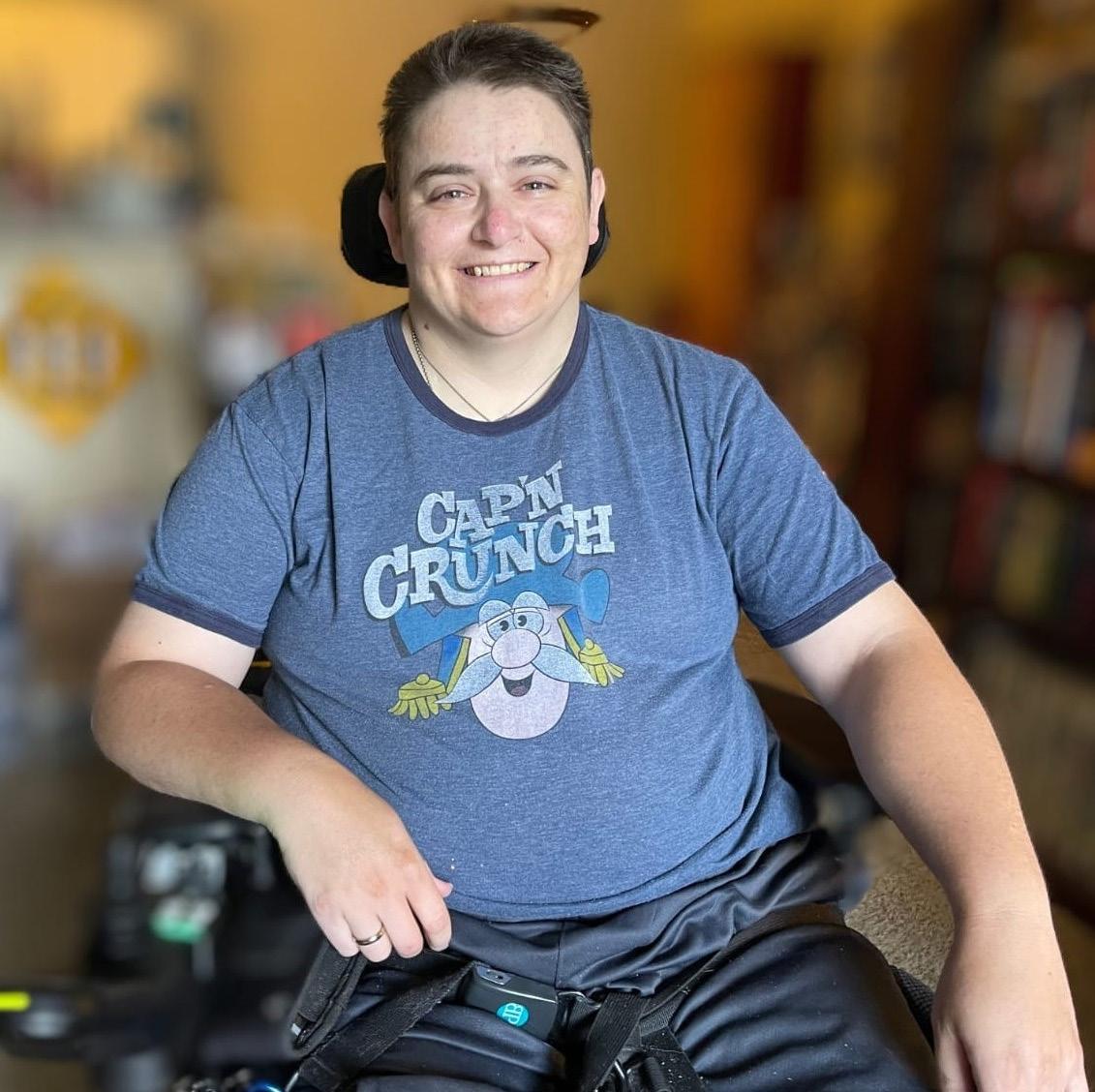
Outstanding Professionalism and Kindness supporting Civil Air Patrol Renne Andrews, Our Wing Commander Kevin McClure, Herminia Bodison, 2Lt.E. Justus, and Air Force Base Honor Guard, Celebrating the Retirement and Future members. July/2023

In Recognition of Outstanding Professionalism and continued Support of the Civil Air Patrol mission, with the presence of our Wing Commander Kevin McClure, C/CMSgt Justus, Renne A.Lt Elizabeth J., and friends and family.July/2023.

C Amn Henry Connolly_C CMSgt Jutus
Cadet Justus Instructing More cadets.

C Amn Johnson, C Amn Gomez, C 1st Lt Brazil Wong-, Capt p. C/CMSgt
Justus, Lt Hayes, 1st Lt Vazquez.

Cadet Justus Instructing More cadets. C Amn Johnson, C Amn Gomez, C 1st Lt Brazil Wong, C/CMSgt Justus, Lt Hayes, 1st Lt Vazquez.
C SSgt Rider- C A1C Moniak. and many Sms, Volunteering in this Awesome Event, from 10-4 pm. The event happens every 2 years, with multiple demonstrations on the ground with performances from the AirForce Air Combat Command F-35 demonstration team and U.S. Army and more, Along with those tents, there will be various Aircraft visitors can walk through and ground static aircraft displays from Civil Air Patrol and University of Fairbanks

Alaska Wing Staff emails
Capt Brandon Anderson brandon.anderson@akwg.cap.gov ig@akwg.cap.gov
Capt Donald (DJ) Burand dj.burand@akwg.cap.gov
Lt Col Stuart Goering stuart.goering@akwg.cap.gov
Capt Samantha (Reux) Stearns reux.stearns@akwg.cap.gov
2d Lt Elizabeth Justus elizabeth.justus@akwg.cap.gov
Lt Col Stephen Sammons stephen.sammons@akwg.cap.gov cs@akwg.cap.gov
Lt Col Brian Porter brian.porter@akwg.cap.gov
Lt Col Bryan Emerson bryan.emerson@akwg.cap.gov dc@akwg.cap.gov
1st Lt Lynda MacPherson lynda.macpherson@akwg.cap.gov
Maj Donald Duff donald.duff@akwg.cap.gov
Capt Karen Padgett karen.padgett@akwg.cap.gov
2d Lt Clint Justus clint.justus@akwg.cap.gov
Maj Donald Duff donald.duff@akwg.cap.gov
2d Lt Elizath Justus elizabeth.justus@akwg.cap.gov
SM Michael Inman michael.inman@akwg.cap.gov
Maj Caleb Newville caleb.newville@akwg.cap.gov
Capt Terrance (Terry) Aldridge terry.aldridge@akwg.cap.gov fm@akwg.cap.gov
2d Lt Clint Justus clint.justus@akwg.cap.gov xp@akwg.cap.gov
Maj Kevin Bottjen kevin.bottjen@akwg.cap.gov hc@akwg.cap.gov
1st Lt Mary Stella mary.stella@akwg.cap.gov ho@akwg.cap.gov
Lt Col Robert Thomas robert.thomas@akwg.cap.gov hs@akwg.cap.gov
1st Lt Mary Stella mary.stella@akwg.cap.gov da@akwg.cap.gov
Lt Col Bryan Emerson bryan.emerson@akwg.cap.gov pa@akwg.cap.gov
If you need any additional help, send a message to: it-helpdesk@akwg.cap.gov
Within the Civil Air Patrol we use several abbreviations.
Let's review them:
Vice Commander ........................................... CV Deputy Commander .................................... CD
Deputy Commander for Cadets ...............CDC
Deputy Commander for Seniors ..... ........CDS
Chief Operating Officer (NHQ only) ... ....COO
Chief of Staff .....................................................CS
Deputy Chief of Staff ....................... ............DCS
Command Chief Master Sgt........................CCC Executive Officer ............................................XO First Sergeant ................................................. CCF or Composite Squadrons only)
.........GVR


CADET PROGRAMS FY 2024 POSITIONS OPEN:
Alaska Wing Cadet Programs is soliciting applications for the following positions. To reply, please email a CAP resume and cover letter to cp@akwg.cap.gov by 1900 hrs (8:00pm) on Thursday, August 31, 2023.
2023 AKWG Cadet Competition Activity Director
FY 2024 CAC (Cadet Advisory Council) Senior Member Advisor
2024 AKWG Encampment Commander
2024 AKWG Glider Flight Academy Activity Director
2024 AKWG Powered Flight Academy Activity Director (need not be a pilot!)
For additional information about the positions, this website will be periodically updated: https://akwg.cap.gov/programs/cp/activities/ads. You may also email the AKWG Director of Cadet Programs, Capt Karen Padgett, at karen.padgett@ akwg.cap.gov with questions or to express interest in assisting with the above activities. 2023 Activity Directors for the above positions are also standing by to answer questions.
All Alaska Wing Senior Members are welcome to apply, even if you have no previous experience with Cadet Programs.
Capt. Karen L. Padgett
Alaska Wing Director of Cadet Programs
Squadron Commander, Lake Hood Cadet Squadron, Anchorage, AK (M) 907.350.8533 karen.padgett@akwg.cap.gov
GoCivilAirPatrol.com
Support Alaska CAP Cadets through Pick.Click.Give.

Through Pick.Click.Give, Alaskans can choose to give a portion (or all) of their Permanent Fund Dividend (PFD) to charity. Thanks to generous donors from all over the state, Alaska Wing Civil Air Patrol Cadet Programs has used donations to support critical mission activities, including aerospace (and other STEM) education, emergency services, and cadet programs. When filling out your PFD application, please consider making a difference by contributing to the Alaska Wing Civil Air Patrol Cadet Programs (just “Search Organizaitons” for the name “Civil”)
Please forward this newsletter to your Alaskan neighbors, friends, coworkers, and family who may like to see what Civil Air Patrol does in Alaska and may like show their appreciation for the great work Civil Air Patrol does.
Helpful Links:
PFD Application Information: https://pfd.alaska.gov/
Pick.Click.Give General Information: https://www.pickclickgive.org/
Pick.Click.Give listing for Alaska Wing (AKWG) Civil Air Patrol (CAP) Cadet Programs: https://www.pickclickgive.org/index.cfm/pfdorgs.info/Civil-AirPatrol-AKWG-Cadet-Programs

Very Respectfully,
Capt. Karen L. Padgett
Alaska Wing Director of Cadet Programs
Squadron Commander, Lake Hood Cadet Squadron, Anchorage, AK
Civil Air Patrol, U.S. Air Force Auxiliary




